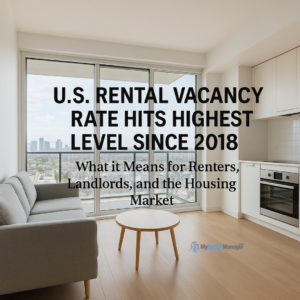As of Q1 2025, the U.S. rental vacancy rate has reached 7.1%, marking its highest point since the third quarter of 2018. This rise up from 6.6% in Q1 2024 signals a possible shift in power dynamics within the rental housing market and may have broad implications for tenants, landlords, investors, and housing policymakers alike.
A Regional Snapshot of Vacancy Trends
The increase in vacancies is not uniform across the country. According to the U.S. Census Bureau data referenced in the article, Southern and Midwestern states are seeing the steepest vacancy rates:
-
South: 8.6%
-
Midwest: 7.6%
-
West: 5.9%
-
Northeast: 5.1%
Urban hubs and suburban areas are also affected, though the distribution is more nuanced. In Metropolitan Statistical Areas (MSAs), the vacancy rate sits at 7.1%, while both principal cities and suburbs hover around 6.4–6.5%. Meanwhile, areas outside of MSAs show a slightly more stable rate at 6.4%.
Vacancy by Property Type: Bigger Isn’t Always Better
Vacancy rates also differ based on the type of rental structure:
-
Single-unit rentals: 6.3%
-
Small multifamily (2–4 units): 7.7%
-
Large multifamily (5+ units): 8.2%
This breakdown suggests that larger apartment complexes are struggling the most to retain or attract renters, possibly due to oversupply from post-pandemic construction booms or lingering affordability issues.
Rent Remains High Despite More Empty Units
One might expect rents to drop when more units are sitting empty but that’s not necessarily happening yet. As of Q1 2025, median asking rent nationwide is $1,468, with regional rates showing continued disparities:
-
West: $1,777
-
Northeast: $1,681
-
South: $1,414
-
Midwest: $1,201
While rents are beginning to stabilize or rise at a slower pace, they remain high in many regions, particularly in the West and Northeast. The current figures suggest that while supply is growing, demand—especially for more affordable options—has not caught up yet.
Homeownership Vacancy Still Low
By contrast, the homeowner vacancy rate is only 1.1%, underscoring the stark divide between the rental and ownership segments of the housing market. The low inventory of homes for sale continues to prop up both home prices and rental demand, although the rising vacancy rate suggests more breathing room is on the horizon for renters.
What This Means for You
For Renters:
More available units mean more choices and potential leverage during lease negotiations, particularly in oversupplied markets. Renters may also benefit from short-term incentives like waived application fees, free months of rent, or improved amenities as landlords compete to fill vacancies.
For Landlords and Property Managers:
This is a crucial moment to reassess marketing strategies, rental pricing, and retention programs. Landlords with large multifamily properties should consider offering more competitive rates or value-added services to attract tenants in a softening market.
For Investors:
The uptick in vacancies may raise red flags for investors in multifamily real estate. However, it could also present opportunities to acquire distressed assets or properties in lower-vacancy markets like the Northeast and West.
For Policymakers:
The rising vacancy rate provides an opportunity to implement more renter-friendly policies, encourage affordable housing development, and address systemic barriers that have limited access to housing.
Outlook: Is This the Start of a Renter’s Market?
The data paints a picture of a gradually tilting market not quite a full-blown renter’s paradise, but certainly one with more balance than in previous years. If construction continues at a healthy pace and demand doesn’t catch up quickly, renters in many parts of the country may finally get a break from years of relentless increases in housing costs.
Still, regional variation remains key. What feels like a renter’s market in Texas or Ohio might still feel like a landlord’s market in California or New York.
To learn more about these trends and what they could mean for your area, read the original article here: Rental Vacancy Rate Hits Highest Level Since 2018 – GlobeSt.

